Assessing the Effectiveness of Pruning in an Olive Orchard Using a Drone and a Multispectral Camera: A Three-Year Study
Abstract
:1. Introduction
2. Materials and Methods
2.1. Study Area
2.2. UAV Flights
2.3. Image Processing
2.4. Sampling and Surveys
2.5. Statistical Analysis
3. Results
4. Discussion
5. Conclusions
Author Contributions
Funding
Data Availability Statement
Conflicts of Interest
References
- Godfray, H.C.J.; Beddington, J.R.; Crute, I.R.; Haddad, L.; Lawrence, D.; Muir, J.F.; Pretty, J.; Robinson, S.; Thomas, S.M.; Toulmin, C. Food Security: The Challenge of Feeding 9 Billion People. Science 2010, 327, 812–818. [Google Scholar] [CrossRef] [PubMed]
- Tilman, D.; Balzer, C.; Hill, J.; Befort, B.L. Global Food Demand and the Sustainable Intensification of Agriculture. Proc. Natl. Acad. Sci. USA 2011, 108, 20260–20264. [Google Scholar] [CrossRef] [PubMed]
- Faostat, F. Statistics, Food and Agriculture Organization of the United Nations, Rome. 2022. Available online: https://www.fao.org/faostat (accessed on 12 March 2024).
- Connor, D.J.; Gómez-del-Campo, M.; Rousseaux, M.C.; Searles, P.S. Structure, Management and Productivity of Hedgerow Olive Orchards: A Review. Sci. Hortic. 2014, 169, 71–93. [Google Scholar] [CrossRef]
- De Gennaro, B.; Notarnicola, B.; Roselli, L.; Tassielli, G. Innovative Olive-Growing Models: An Environmental and Economic Assessment. J. Clean. Prod. 2012, 28, 70–80. [Google Scholar] [CrossRef]
- Noori, O.; Panda, S.S. Site-Specific Management of Common Olive: Remote Sensing, Geospatial, and Advanced Image Processing Applications. Comput. Electron. Agric. 2016, 127, 680–689. [Google Scholar] [CrossRef]
- Perna, C.; Sarri, D.; Pagliai, A.; Priori, S.; Vieri, M. Assessment of Soil and Vegetation Index Variability in a Traditional Olive Grove: A Case Study; Springer: Berlin/Heidelberg, Germany, 2022; pp. 835–842. [Google Scholar]
- Sola-Guirado, R.R.; Castillo-Ruiz, F.J.; Jiménez-Jiménez, F.; Blanco-Roldan, G.L.; Castro-Garcia, S.; Gil-Ribes, J.A. Olive Actual “on Year” Yield Forecast Tool Based on the Tree Canopy Geometry Using UAS Imagery. Sensors 2017, 17, 1743. [Google Scholar] [CrossRef] [PubMed]
- Perna, C.; Pagliai, A.; Lisci, R.; Pinhero Amantea, R.; Vieri, M.; Sarri, D.; Masella, P. Relationship between Height and Exposure in Multispectral Vegetation Index Response and Product Characteristics in a Traditional Olive Orchard. Sensors 2024, 24, 2557. [Google Scholar] [CrossRef] [PubMed]
- Agam, N.; Segal, E.; Peeters, A.; Levi, A.; Dag, A.; Yermiyahu, U.; Ben-Gal, A. Spatial Distribution of Water Status in Irrigated Olive Orchards by Thermal Imaging. Precis. Agric. 2014, 15, 346–359. [Google Scholar] [CrossRef]
- Caruso, G.; Zarco-Tejada, P.J.; González-Dugo, V.; Moriondo, M.; Tozzini, L.; Palai, G.; Rallo, G.; Hornero, A.; Primicerio, J.; Gucci, R. High-Resolution Imagery Acquired from an Unmanned Platform to Estimate Biophysical and Geometrical Parameters of Olive Trees under Different Irrigation Regimes. PLoS ONE 2019, 14, e0210804. [Google Scholar] [CrossRef]
- Catania, P.; Roma, E.; Orlando, S.; Vallone, M. Evaluation of Multispectral Data Acquired from UAV Platform in Olive Orchard. Horticulturae 2023, 9, 133. [Google Scholar] [CrossRef]
- Díaz-Varela, R.A.; De la Rosa, R.; León, L.; Zarco-Tejada, P.J. High-Resolution Airborne UAV Imagery to Assess Olive Tree Crown Parameters Using 3D Photo Reconstruction: Application in Breeding Trials. Remote Sens. 2015, 7, 4213–4232. [Google Scholar] [CrossRef]
- Xie, Q.; Huang, W.; Liang, D.; Chen, P.; Wu, C.; Yang, G.; Zhang, J.; Huang, L.; Zhang, D. Leaf Area Index Estimation Using Vegetation Indices Derived from Airborne Hyperspectral Images in Winter Wheat. IEEE J. Sel. Top. Appl. Earth Obs. Remote Sens. 2014, 7, 3586–3594. [Google Scholar] [CrossRef]
- Xue, J.; Su, B. Significant Remote Sensing Vegetation Indices: A Review of Developments and Applications. J. Sens. 2017, 2017, 1353691. [Google Scholar] [CrossRef]
- Rouse, J.W.; Haas, R.H.; Schell, J.A.; Deering, D.W.; Harlan, J.C. Monitoring the Vernal Advancement and Retrogradation (Green Wave Effect) of Natural Vegetation. NASA/GSFC Type III Final. Rep. Greenbelt Md 1974, 371. Available online: https://ntrs.nasa.gov/citations/19740022555 (accessed on 12 March 2024).
- Carlson, T.N.; Ripley, D.A. On the Relation between NDVI, Fractional Vegetation Cover, and Leaf Area Index. Remote Sens. Environ. 1997, 62, 241–252. [Google Scholar] [CrossRef]
- Ben-Gal, A.; Agam, N.; Alchanatis, V.; Cohen, Y.; Yermiyahu, U.; Zipori, I.; Presnov, E.; Sprintsin, M.; Dag, A. Evaluating Water Stress in Irrigated Olives: Correlation of Soil Water Status, Tree Water Status, and Thermal Imagery. Irrig. Sci. 2009, 27, 367–376. [Google Scholar] [CrossRef]
- Roma, E.; Laudicina, V.A.; Vallone, M.; Catania, P. Application of Precision Agriculture for the Sustainable Management of Fertilization in Olive Groves. Agronomy 2023, 13, 324. [Google Scholar] [CrossRef]
- Martinez-Guanter, J.; Agüera, P.; Agüera, J.; Pérez-Ruiz, M. Spray and Economics Assessment of a UAV-Based Ultra-Low-Volume Application in Olive and Citrus Orchards. Precis. Agric. 2020, 21, 226–243. [Google Scholar] [CrossRef]
- Jiménez-Brenes, F.M.; López-Granados, F.; De Castro, A.; Torres-Sánchez, J.; Serrano, N.; Peña, J. Quantifying Pruning Impacts on Olive Tree Architecture and Annual Canopy Growth by Using UAV-Based 3D Modelling. Plant Methods 2017, 13, 55. [Google Scholar] [CrossRef]
- Villalobos, F.; Testi, L.; Hidalgo, J.; Pastor, M.; Orgaz, F. Modelling Potential Growth and Yield of Olive (Olea Europaea L.) Canopies. Eur. J. Agron. 2006, 24, 296–303. [Google Scholar] [CrossRef]
- Ferguson, L.; Glozer, K.; Crisosto, C.; Rosa, U.; Castro-Garcia, S.; Fichtner, E.; Guinard, J.; Lee, S.; Krueger, W.; Miles, J. Improving Canopy Contact Olive Harvester Efficiency with Mechanical Pruning. In Proceedings of the I International Symposium on Mechanical Harvesting and Handling Systems of Fruits and Nuts, Lake Alfred, FL, USA, 1–4 April 2012; pp. 83–87. [Google Scholar]
- Caruso, G.; Palai, G.; Marra, F.P.; Caruso, T. High-Resolution UAV Imagery for Field Olive (Olea Europaea L.) Phenotyping. Horticulturae 2021, 7, 258. [Google Scholar] [CrossRef]
- Velázquez-Martí, B.; Fernández-González, E.; López-Cortés, I.; Salazar-Hernández, D.M. Quantification of the Residual Biomass Obtained from Pruning of Trees in Mediterranean Olive Groves. Biomass Bioenergy 2011, 35, 3208–3217. [Google Scholar] [CrossRef]
- Miranda-Fuentes, A.; Llorens, J.; Gamarra-Diezma, J.L.; Gil-Ribes, J.A.; Gil, E. Towards an Optimized Method of Olive Tree Crown Volume Measurement. Sensors 2015, 15, 3671–3687. [Google Scholar] [CrossRef] [PubMed]
- Rosell, J.; Sanz, R. A Review of Methods and Applications of the Geometric Characterization of Tree Crops in Agricultural Activities. Comput. Electron. Agric. 2012, 81, 124–141. [Google Scholar] [CrossRef]
- Jurado, J.M.; Ortega, L.; Cubillas, J.J.; Feito, F. Multispectral Mapping on 3D Models and Multi-Temporal Monitoring for Individual Characterization of Olive Trees. Remote Sens. 2020, 12, 1106. [Google Scholar] [CrossRef]
- Kottek, M.; Grieser, J.; Beck, C.; Rudolf, B.; Rubel, F. World Map of the Köppen-Geiger Climate Classification Updated. Meteorol. Z. 2006, 15, 259–263. [Google Scholar] [CrossRef]
- Roma, E.; Catania, P.; Vallone, M.; Orlando, S. Unmanned Aerial Vehicle and Proximal Sensing of Vegetation Indices in Olive Tree (Olea Europaea). J. Agric. Eng. 2023, 54. [Google Scholar] [CrossRef]
- Catania, P.; Comparetti, A.; Febo, P.; Morello, G.; Orlando, S.; Roma, E.; Vallone, M. Positioning Accuracy Comparison of GNSS Receivers Used for Mapping and Guidance of Agricultural Machines. Agronomy 2020, 10, 924. [Google Scholar] [CrossRef]
- QGIS. Geographic Information System. 2022. Available online: https://www.qgis.org/it/site/ (accessed on 1 January 2022).
- Blaschke, T. Object Based Image Analysis for Remote Sensing. ISPRS J. Photogramm. Remote Sens. 2010, 65, 2–16. [Google Scholar] [CrossRef]
- RStudio Team. RStudio: Integrated Development Environment for R; RStudio Team: Boston, MA, USA, 2015. [Google Scholar]
- Anifantis, A.S.; Camposeo, S.; Vivaldi, G.A.; Santoro, F.; Pascuzzi, S. Comparison of UAV Photogrammetry and 3D Modeling Techniques with Other Currently Used Methods for Estimation of the Tree Row Volume of a Super-High-Density Olive Orchard. Agriculture 2019, 9, 233. [Google Scholar] [CrossRef]
- Zarco-Tejada, P.J.; Diaz-Varela, R.; Angileri, V.; Loudjani, P. Tree Height Quantification Using Very High Resolution Imagery Acquired from an Unmanned Aerial Vehicle (UAV) and Automatic 3D Photo-Reconstruction Methods. Eur. J. Agron. 2014, 55, 89–99. [Google Scholar] [CrossRef]
- Barranco-Navero, D.; Fernandez Escobar, R.; Rallo Romero, L. El Cultivo Del Olivo, 7th ed.; Mundi-Prensa Libros: Madrid, Spain, 2017; ISBN 84-8476-714-0. [Google Scholar]
- Torres-Sánchez, J.; López-Granados, F.; Serrano, N.; Arquero, O.; Peña, J.M. High-Throughput 3-D Monitoring of Agricultural-Tree Plantations with Unmanned Aerial Vehicle (UAV) Technology. PLoS ONE 2015, 10, e0130479. [Google Scholar] [CrossRef] [PubMed]
- Albarracín, V.; Hall, A.J.; Searles, P.S.; Rousseaux, M.C. Responses of Vegetative Growth and Fruit Yield to Winter and Summer Mechanical Pruning in Olive Trees. Sci. Hortic. 2017, 225, 185–194. [Google Scholar] [CrossRef]
- Rodrigues, M.Â.; Lopes, J.I.; Ferreira, I.Q.; Arrobas, M. Olive Tree Response to the Severity of Pruning. Turk. J. Agric. For. 2018, 42, 103–113. [Google Scholar] [CrossRef]
- Farinelli, D.; Onorati, L.; Ruffolo, M.; Tombesi, A. Mechanical Pruning of Adult Olive Trees and Influence on Yield and on Efficiency of Mechanical Harvesting. In Proceedings of the XXVIII International Horticultural Congress on Science and Horticulture for People (IHC2010): Olive Trends Symposium, Lisbon, Portugal, 22 August 2010; pp. 203–209. [Google Scholar]
- Castillo-Ruiz, F.J.; Castro-Garcia, S.; Blanco-Roldan, G.L.; Sola-Guirado, R.R.; Gil-Ribes, J.A. Olive Crown Porosity Measurement Based on Radiation Transmittance: An Assessment of Pruning Effect. Sensors 2016, 16, 723. [Google Scholar] [CrossRef]
- Lo Bianco, R.; Carella, A.; Massenti, R. Testing Effects of Vapor Pressure Deficit on Fruit Growth: A Comparative Approach Using Peach, Mango, Olive, Orange, and Loquat. Front. Plant Sci. 2023, 14, 1294195. [Google Scholar]
- Allen, W.A.; Richardson, A.J. Interaction of Light with a Plant Canopy. JOSA 1968, 58, 1023–1028. [Google Scholar] [CrossRef]
- Tombesi, A.; Boco, M.; Pilli, M.; Farinelli, D. Influence of Canopy Density on Efficiency of Trunk Shaker on Olive Mechanical Harvesting. In Proceedings of the IV International Symposium on Olive Growing, Valenzano, Italy, 25–30 September 2000; pp. 291–294. [Google Scholar]
- Miranda-Fuentes, A.; Llorens, J.; Rodríguez-Lizana, A.; Cuenca, A.; Gil, E.; Blanco-Roldán, G.; Gil-Ribes, J. Assessing the Optimal Liquid Volume to Be Sprayed on Isolated Olive Trees According to Their Canopy Volumes. Sci. Total Environ. 2016, 568, 296–305. [Google Scholar] [CrossRef]
- Planas, S.; Román, C.; Sanz, R.; Rosell-Polo, J.R. Bases for Pesticide Dose Expression and Adjustment in 3D Crops and Comparison of Decision Support Systems. Sci. Total Environ. 2022, 806, 150357. [Google Scholar] [CrossRef]
- Orlando, S.; Greco, C.; Tuttolomondo, T.; Leto, C.; Cammalleri, I.; La Bella, S. Identification of Energy Hubs for the Exploitation of Residual Biomass in an Area of Western Sicily. In Proceedings of the EUBCE 2017 Online Conference Proceedings, Stockholm, Sweden, 12–15 June 2017; pp. 64–69. [Google Scholar]
- Fernández-Escobar, R.; Marín, L. Nitrogen Fertilization in Olive Orchards. In Proceedings of the III International Symposium on Olive Growing, Chania, Crete, Greece, 22–26 September 1997; pp. 333–336. [Google Scholar]
- Van Evert, F.K.; Gaitán-Cremaschi, D.; Fountas, S.; Kempenaar, C. Can Precision Agriculture Increase the Profitability and Sustainability of the Production of Potatoes and Olives? Sustainability 2017, 9, 1863. [Google Scholar] [CrossRef]
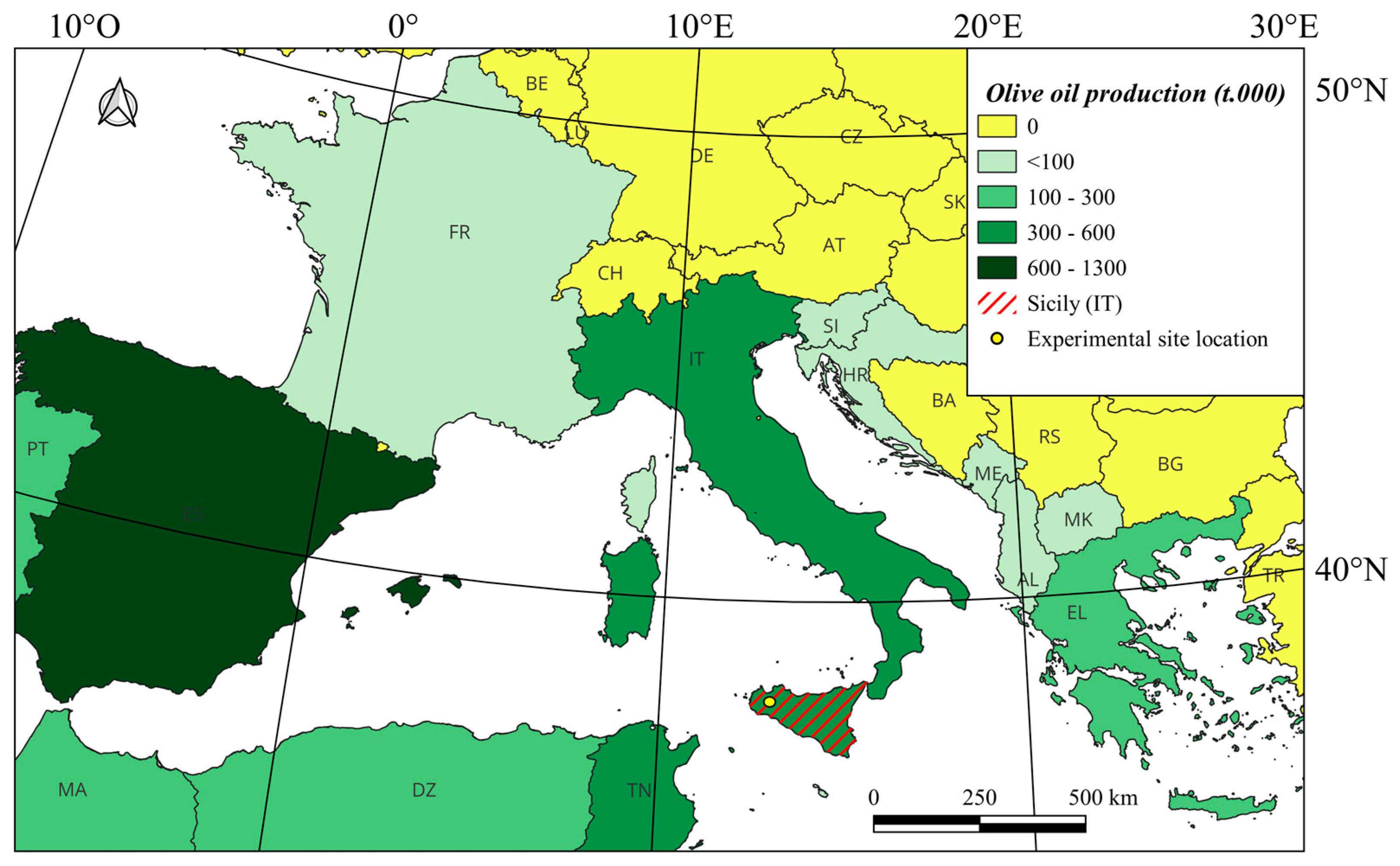

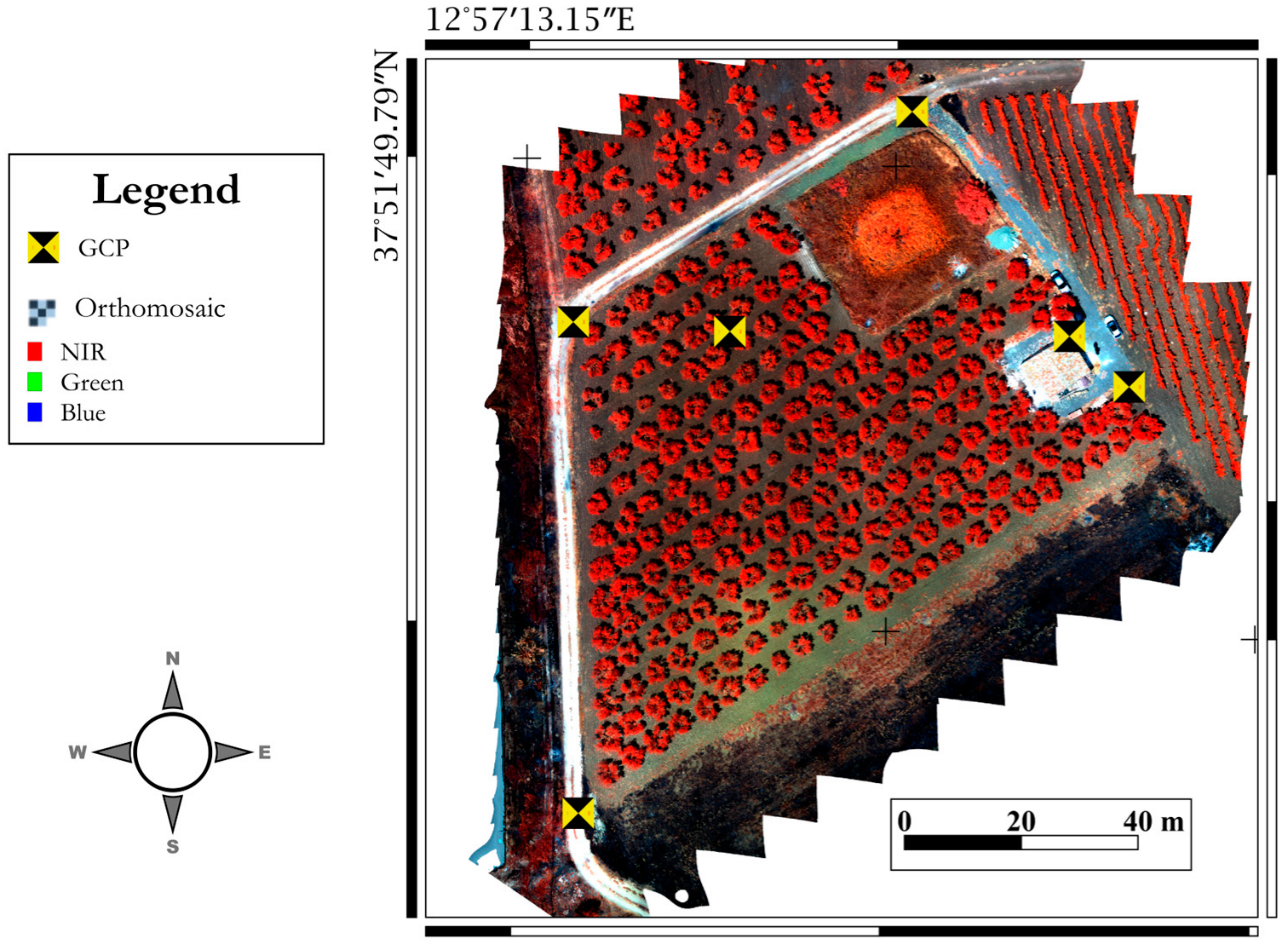
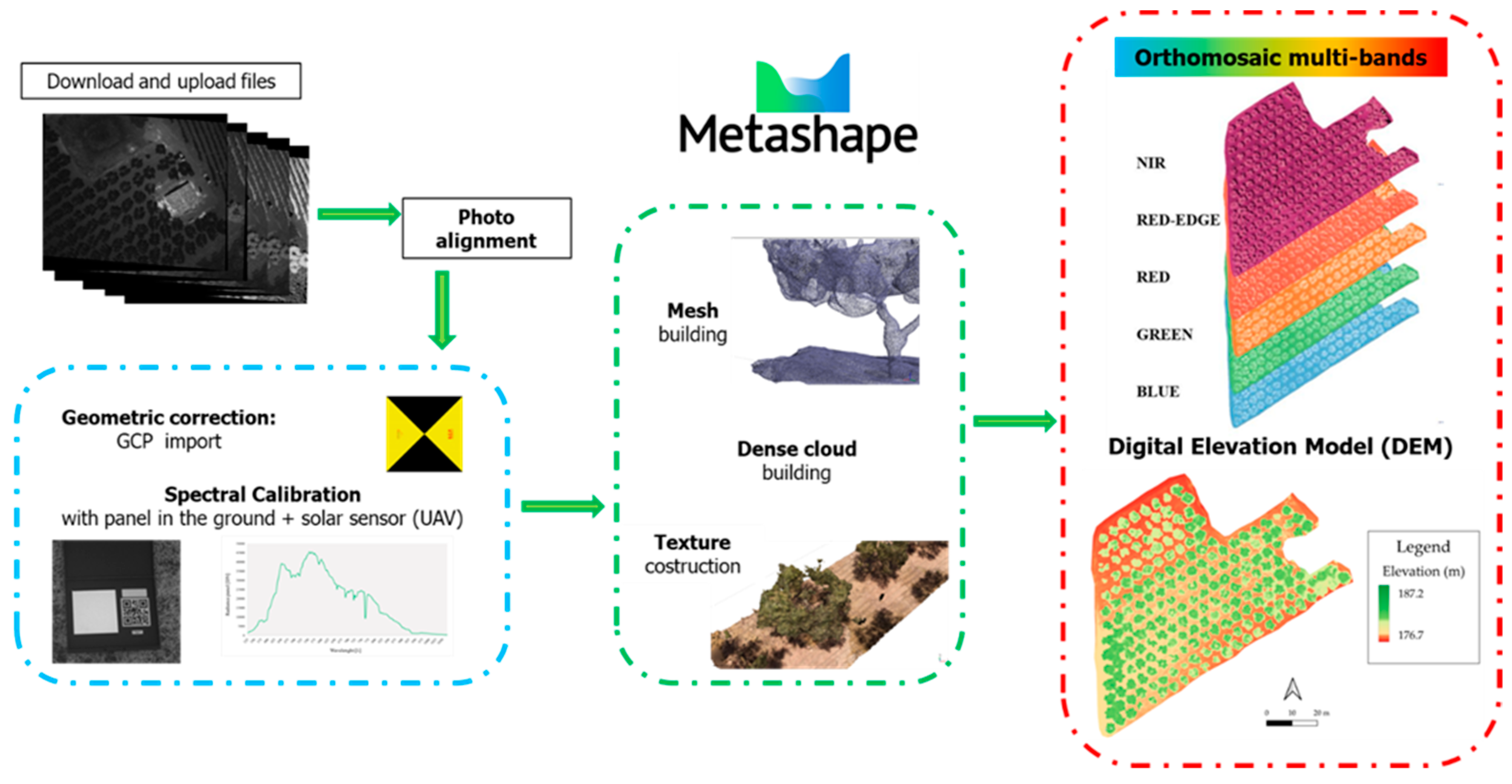
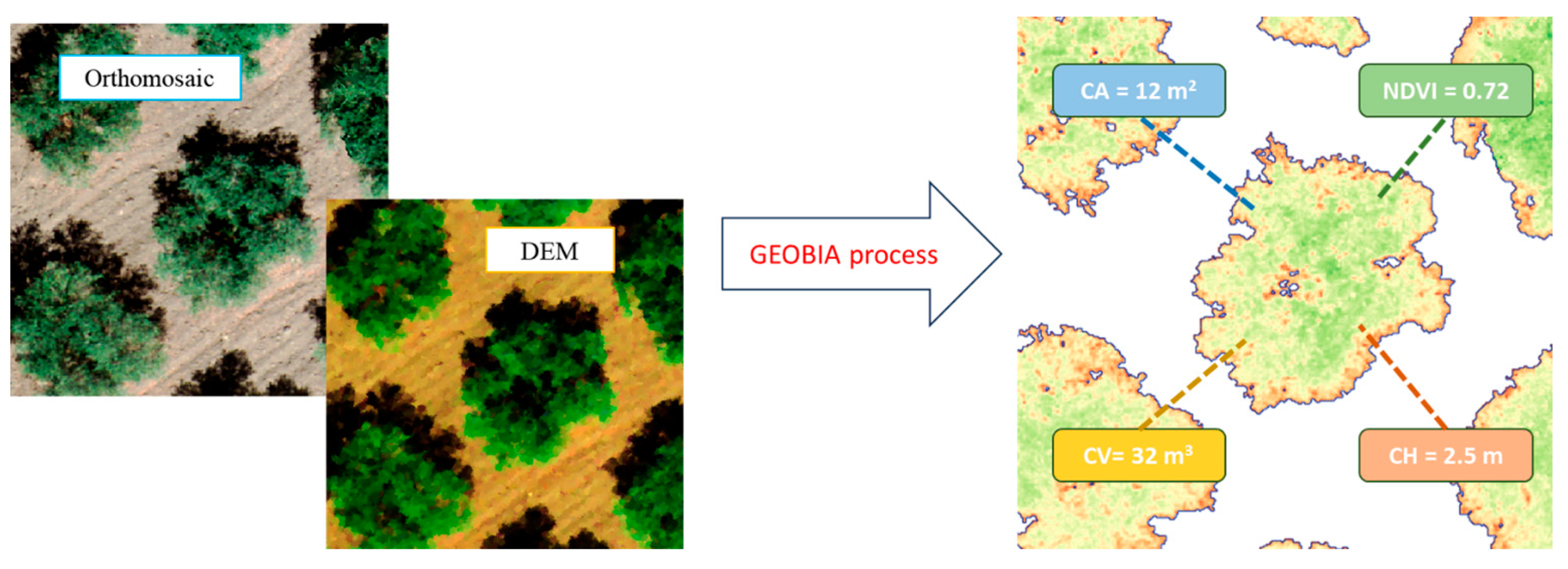
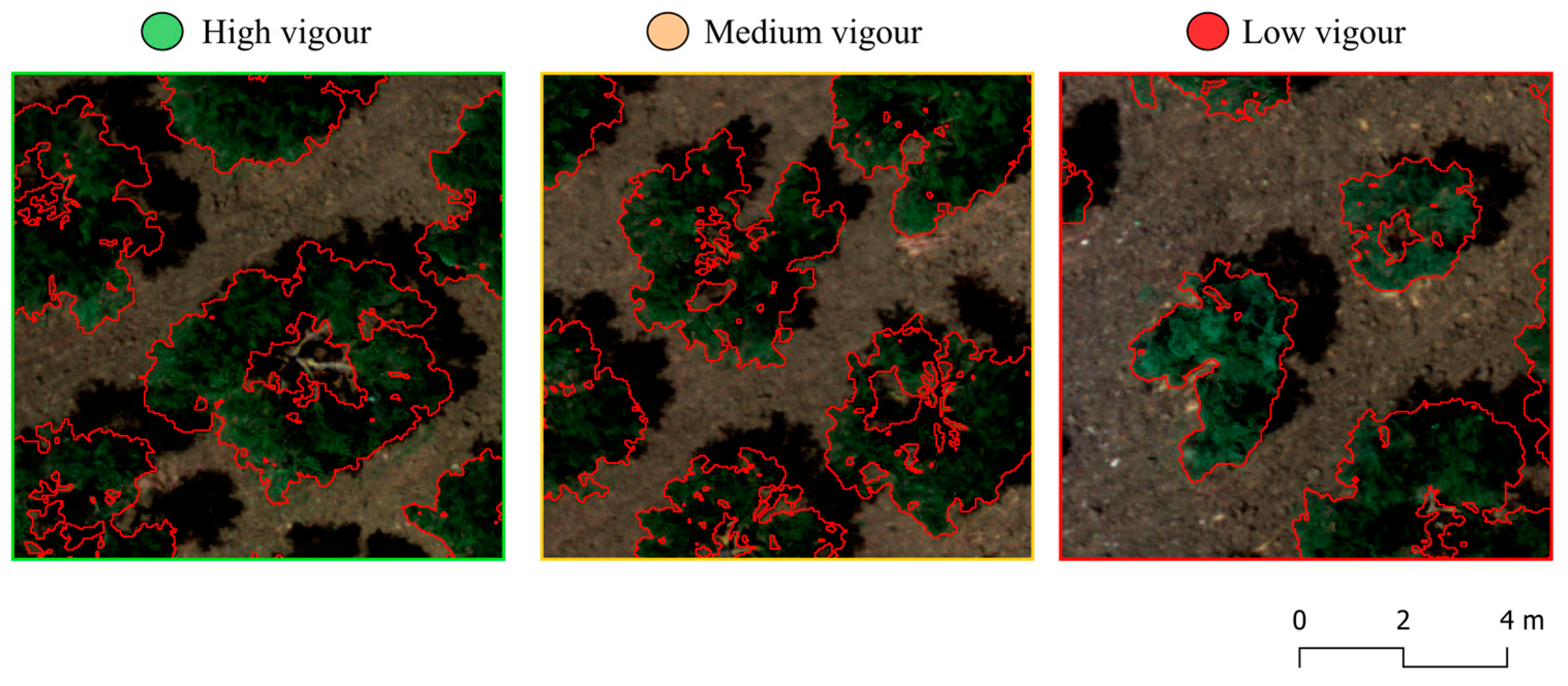
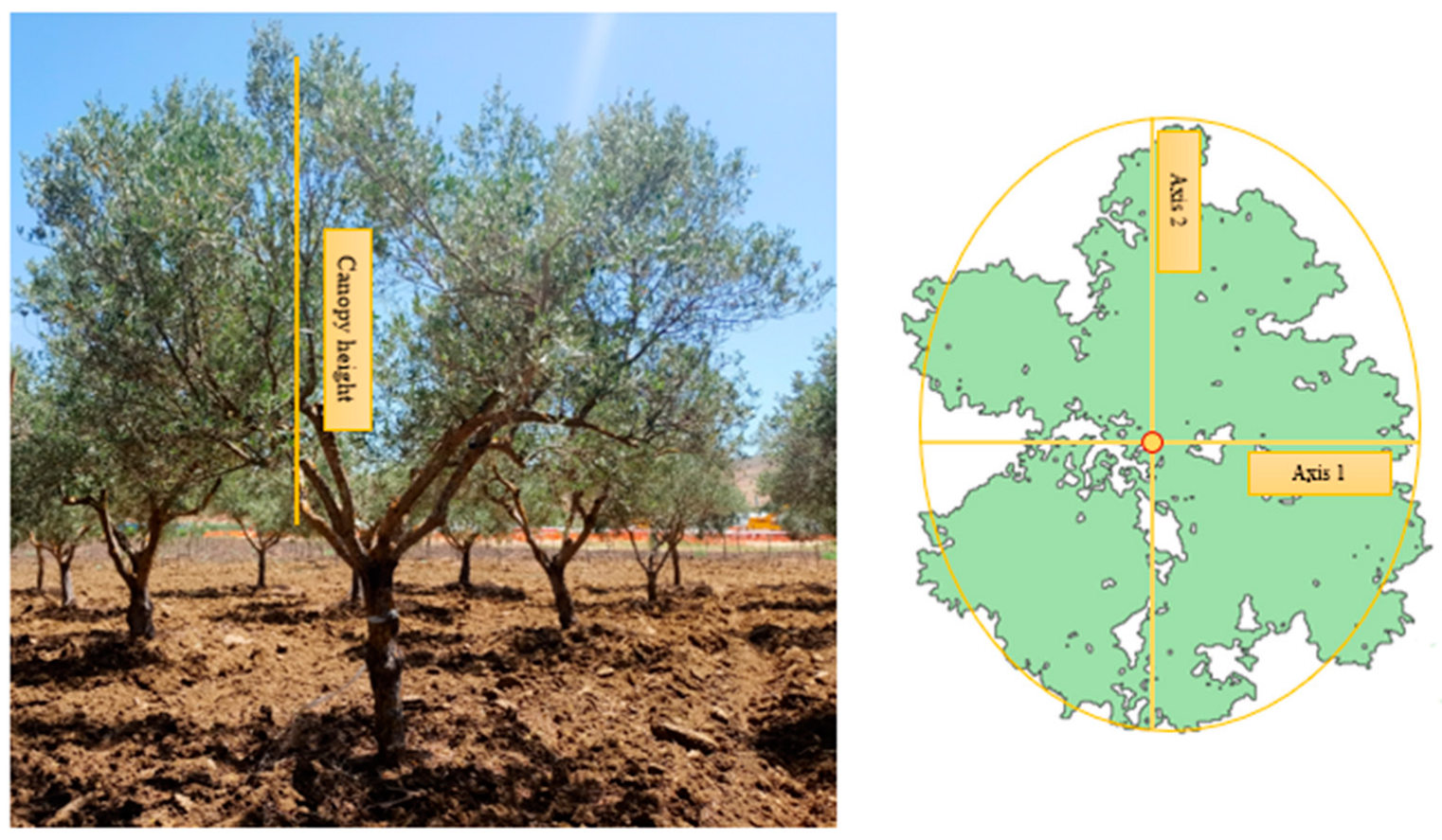

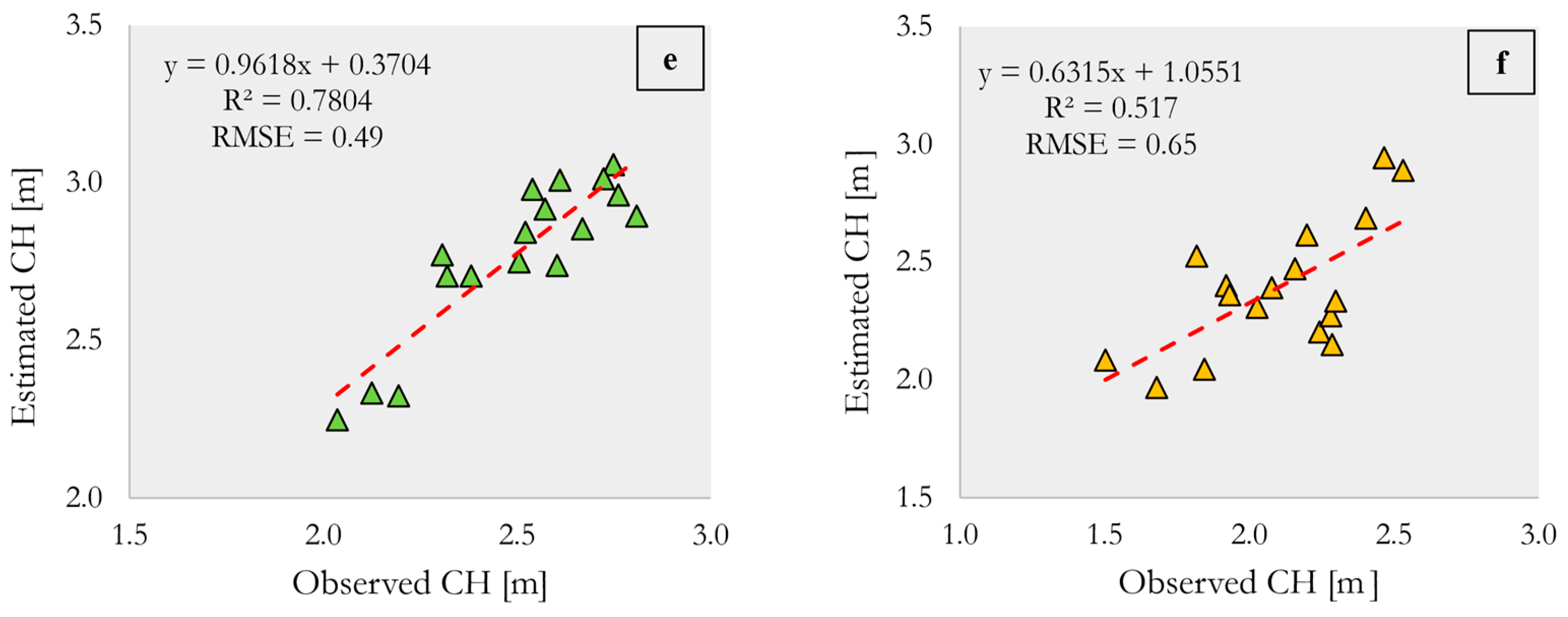
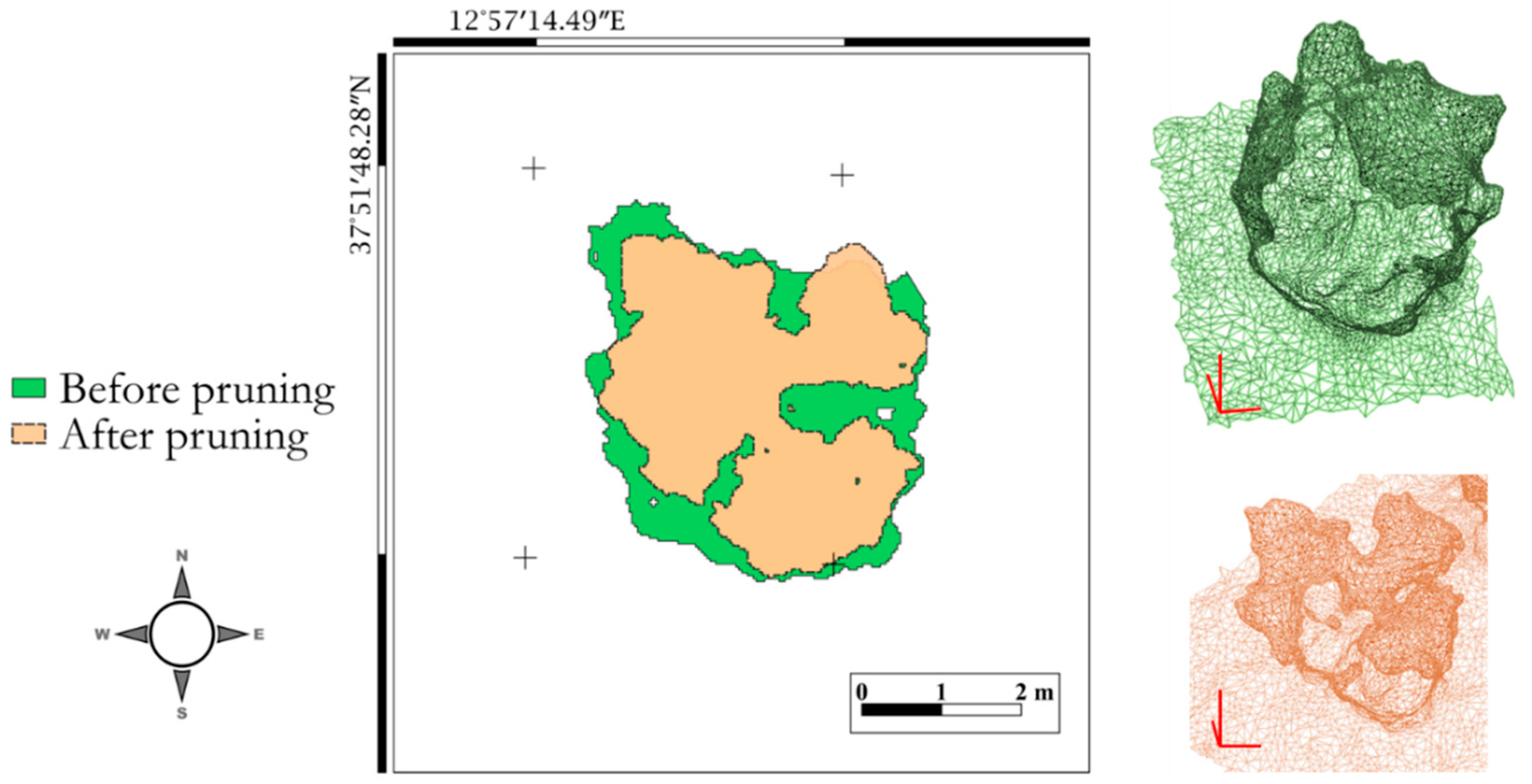
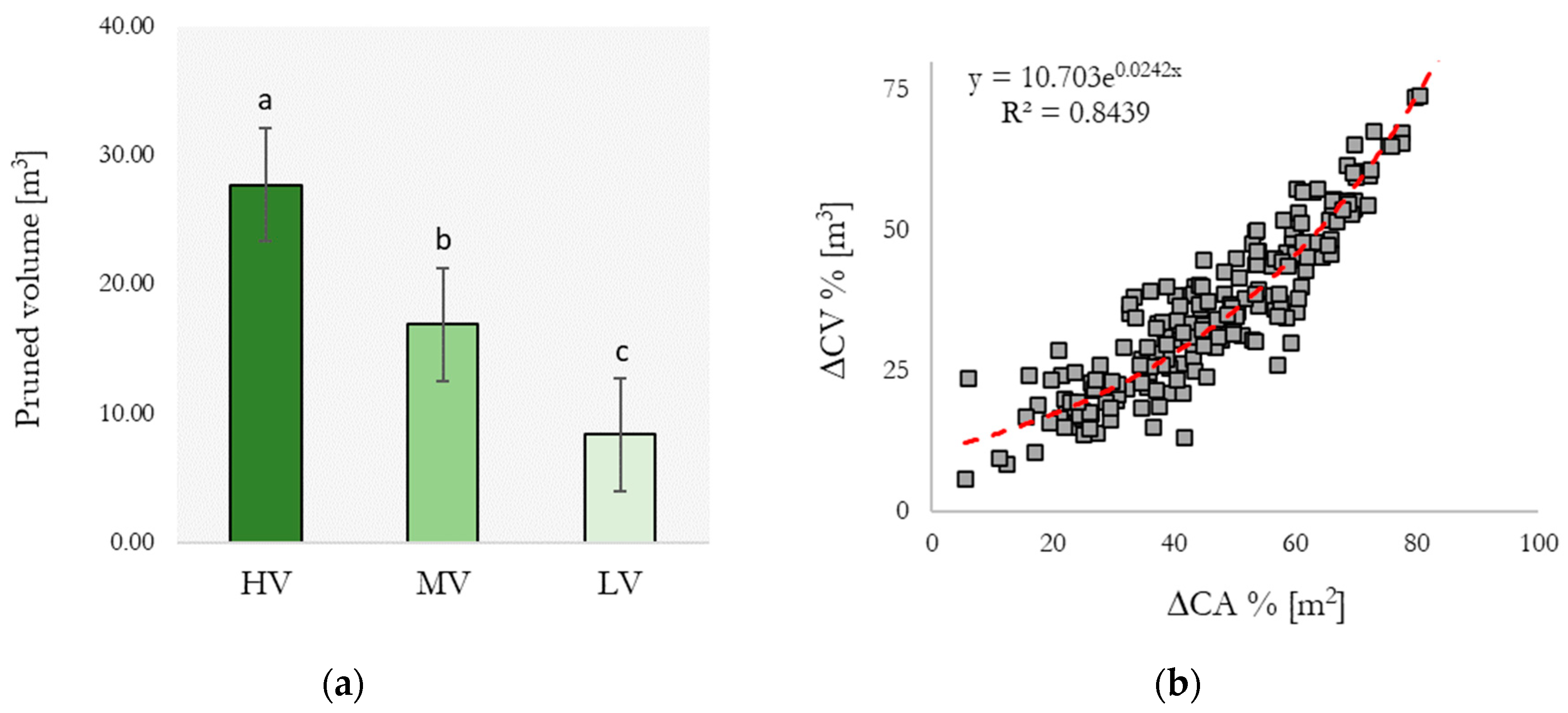
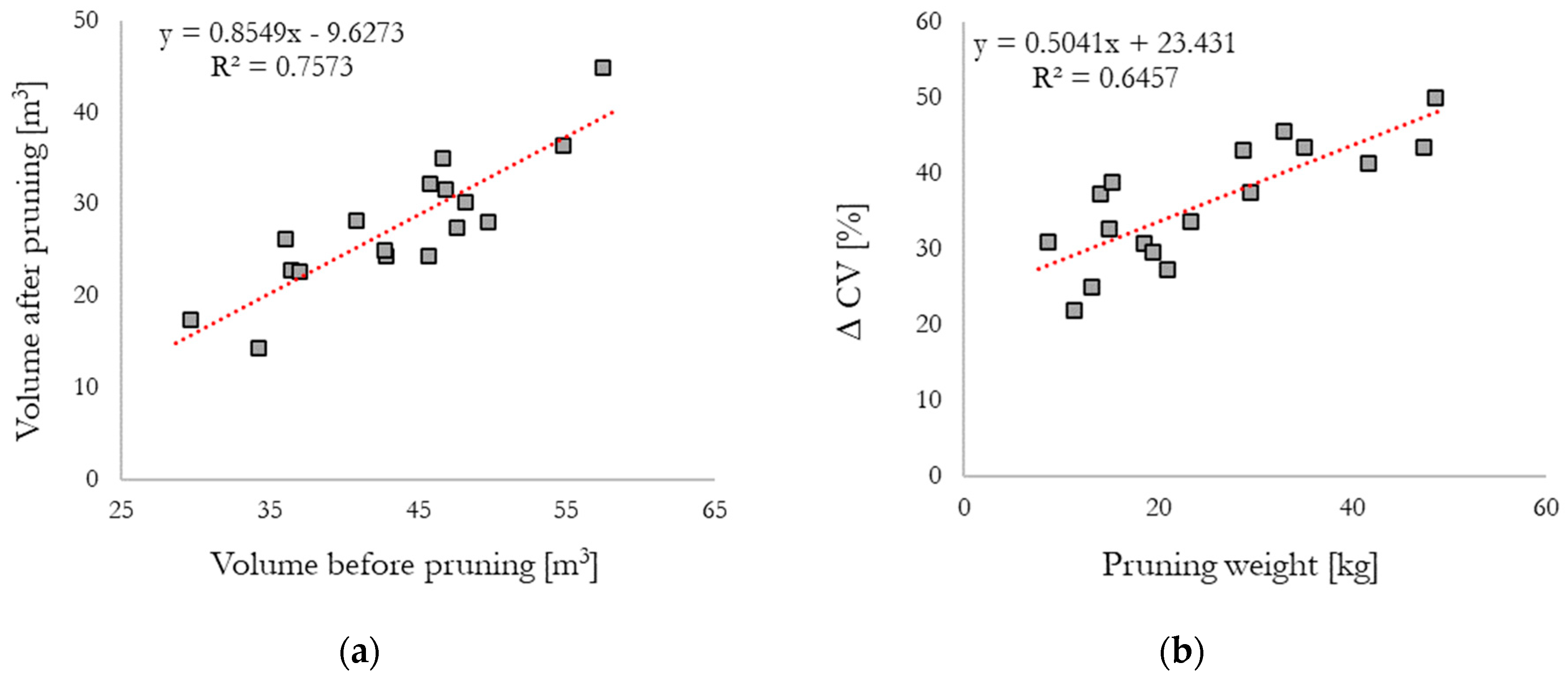
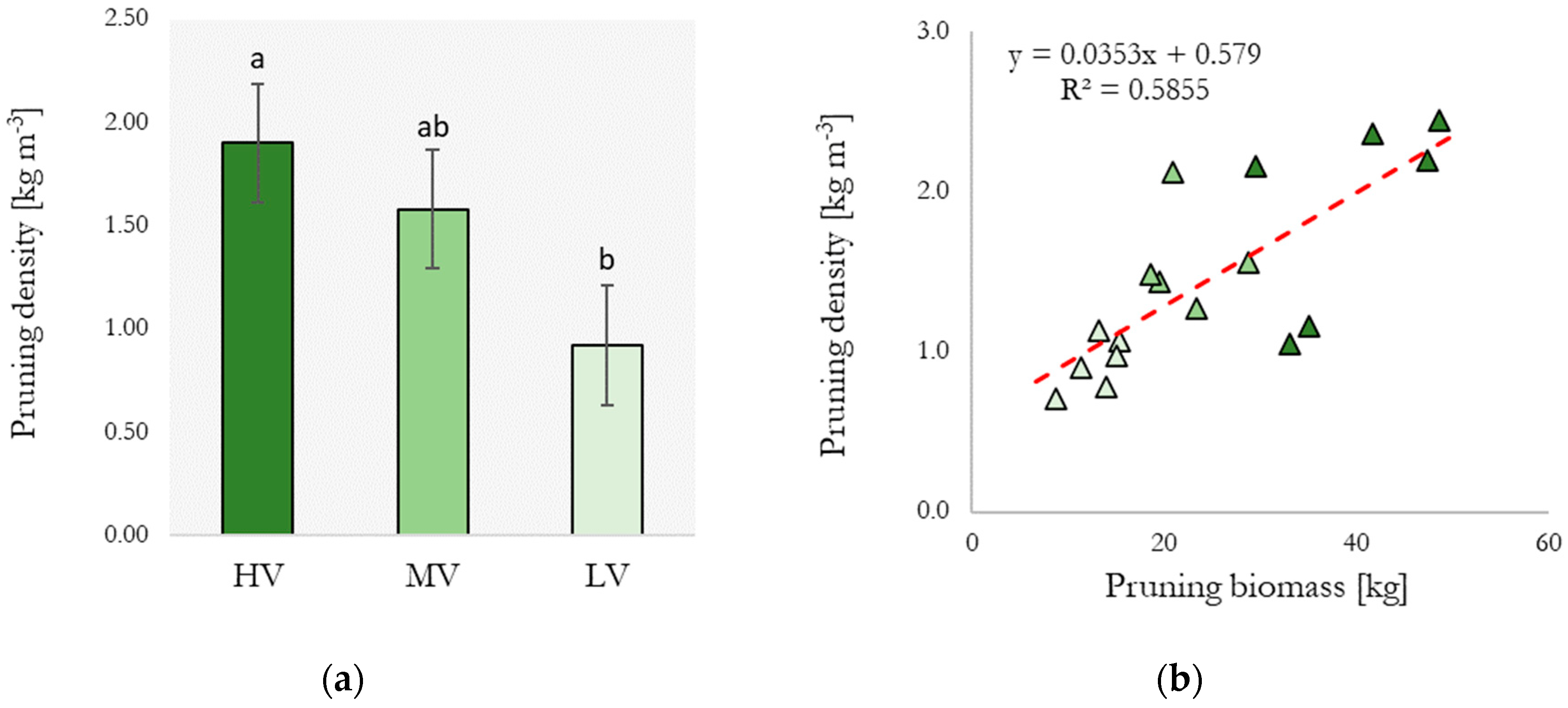

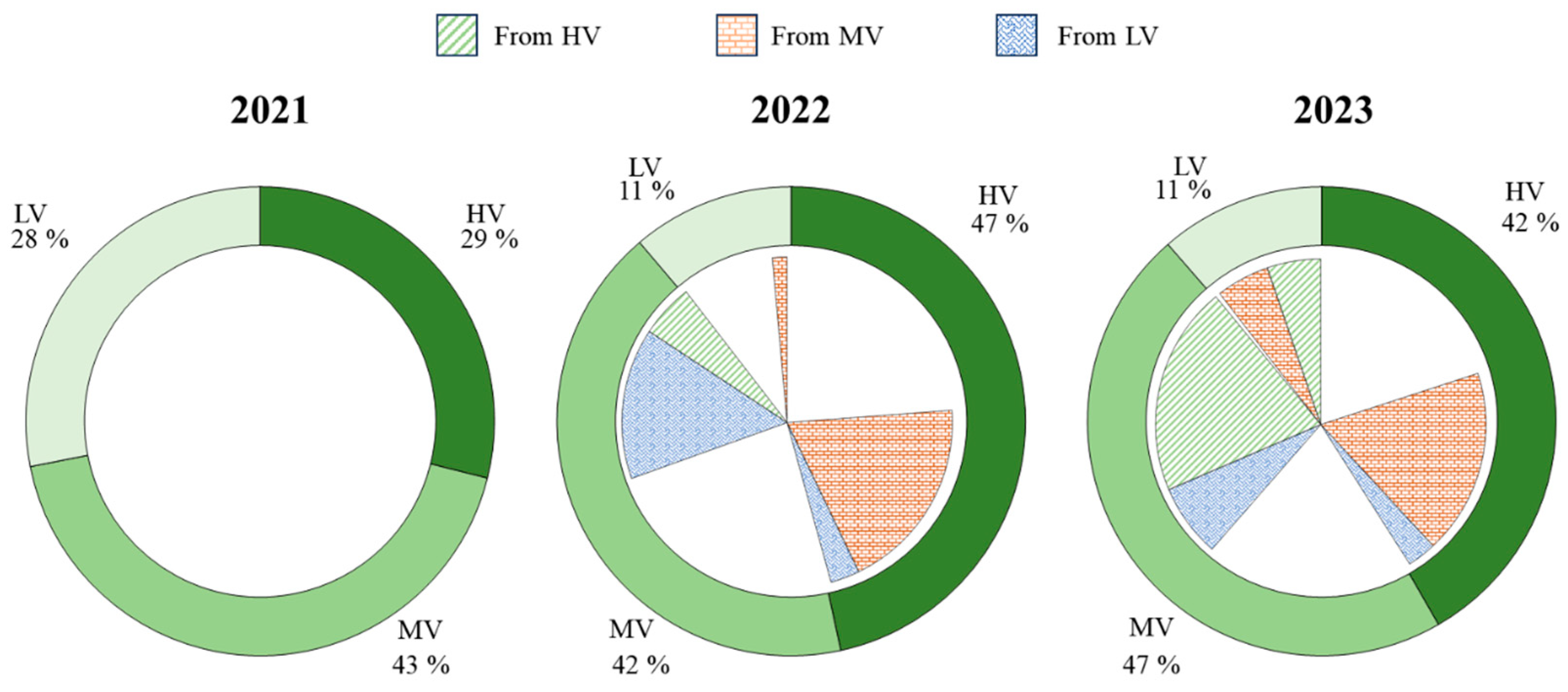
| Before | After | ||||
|---|---|---|---|---|---|
| Mean ± sd | Range | Mean ± sd | Range | ||
| NDVI | HV | 0.84 ± 0.02 a | 0.73–0.91 | 0.73 ± 0.04 a | 0.59–0.81 |
| MV | 0.81 ± 0.01 b | 0.75–0.83 | 0.74 ± 0.03 a | 0.62–0.81 | |
| LV | 0.78 ± 0.02 c | 0.72–0.82 | 0.71 ± 0.04 b | 0.64–0.79 | |
| CA | HV | 18.43 ± 2.3 a | 15.6–23.3 | 10.97 ± 2.7 a | 4.2–19.2 |
| [m2] | MV | 13.74 ± 1.0 b | 11.7–15.5 | 9.4 ± 1.8 ab | 4.9–13.1 |
| LV | 9.53 ± 2.3 c | 3.6–12 | 6.62 ± 1.9 b | 2.5–9.7 | |
| CV | HV | 54.10 ± 7.8 a | 54.1–72.3 | 26.38 ± 8.1 a | 10.0–34.9 |
| [m3] | MV | 38.3 ± 4.1 b | 30.6–45.1 | 21.10 ± 6.0 ab | 7.7–30.2 |
| LV | 23.94 ± 7.1 c | 12.0–31.1 | 15.55 ± 6.0 b | 5.1–27.9 | |
| HV | MV | LV | ||||
|---|---|---|---|---|---|---|
| NDVI | mean ± sd | Range | mean ± sd | Range | mean ± sd | Range |
| 2021 | 0.63 ± 0.02 b | 0.62–0.64 | 0.60 ± 0.03 b | 0.59–0.61 | 0.58 ± 0.03 c | 0.57–0.59 |
| 2022 | 0.67 ± 0.03 a | 0.66–0.68 | 0.65 ± 0.03 a | 0.64–0.65 | 0.63 ± 0.04 a | 0.62–0.64 |
| 2023 | 0.61 ± 0.03 c | 0.60–0.62 | 0.61 ± 0.03 b | 0.60–0.61 | 0.61 ± 0.03 b | 0.60–0.62 |
| CA | mean ± sd | Range | mean ± sd | Range | mean ± sd | Range |
| 2021 | 12.88 ± 2.1 b | 12.0–13.8 | 9.97 ± 0.86 b | 9.6–10.4 | 6.49 ± 1.60 c | 5.6–7.4 |
| 2022 | 14.92 ± 3.1 a | 14.0–15.8 | 12.28 ± 1.95 a | 11.9–12.7 | 9.04 ± 2.63 b | 8.1–9.9 |
| 2023 | 12.39 ± 2.8 b | 11.5–13.2 | 11.72 ± 0.48 ab | 9.7–13.7 | 11.70 ± 3.53 a | 10.8–12.6 |
Disclaimer/Publisher’s Note: The statements, opinions and data contained in all publications are solely those of the individual author(s) and contributor(s) and not of MDPI and/or the editor(s). MDPI and/or the editor(s) disclaim responsibility for any injury to people or property resulting from any ideas, methods, instructions or products referred to in the content. |
© 2024 by the authors. Licensee MDPI, Basel, Switzerland. This article is an open access article distributed under the terms and conditions of the Creative Commons Attribution (CC BY) license (https://creativecommons.org/licenses/by/4.0/).
Share and Cite
Roma, E.; Catania, P.; Vallone, M.; Orlando, S. Assessing the Effectiveness of Pruning in an Olive Orchard Using a Drone and a Multispectral Camera: A Three-Year Study. Agronomy 2024, 14, 1023. https://doi.org/10.3390/agronomy14051023
Roma E, Catania P, Vallone M, Orlando S. Assessing the Effectiveness of Pruning in an Olive Orchard Using a Drone and a Multispectral Camera: A Three-Year Study. Agronomy. 2024; 14(5):1023. https://doi.org/10.3390/agronomy14051023
Chicago/Turabian StyleRoma, Eliseo, Pietro Catania, Mariangela Vallone, and Santo Orlando. 2024. "Assessing the Effectiveness of Pruning in an Olive Orchard Using a Drone and a Multispectral Camera: A Three-Year Study" Agronomy 14, no. 5: 1023. https://doi.org/10.3390/agronomy14051023






